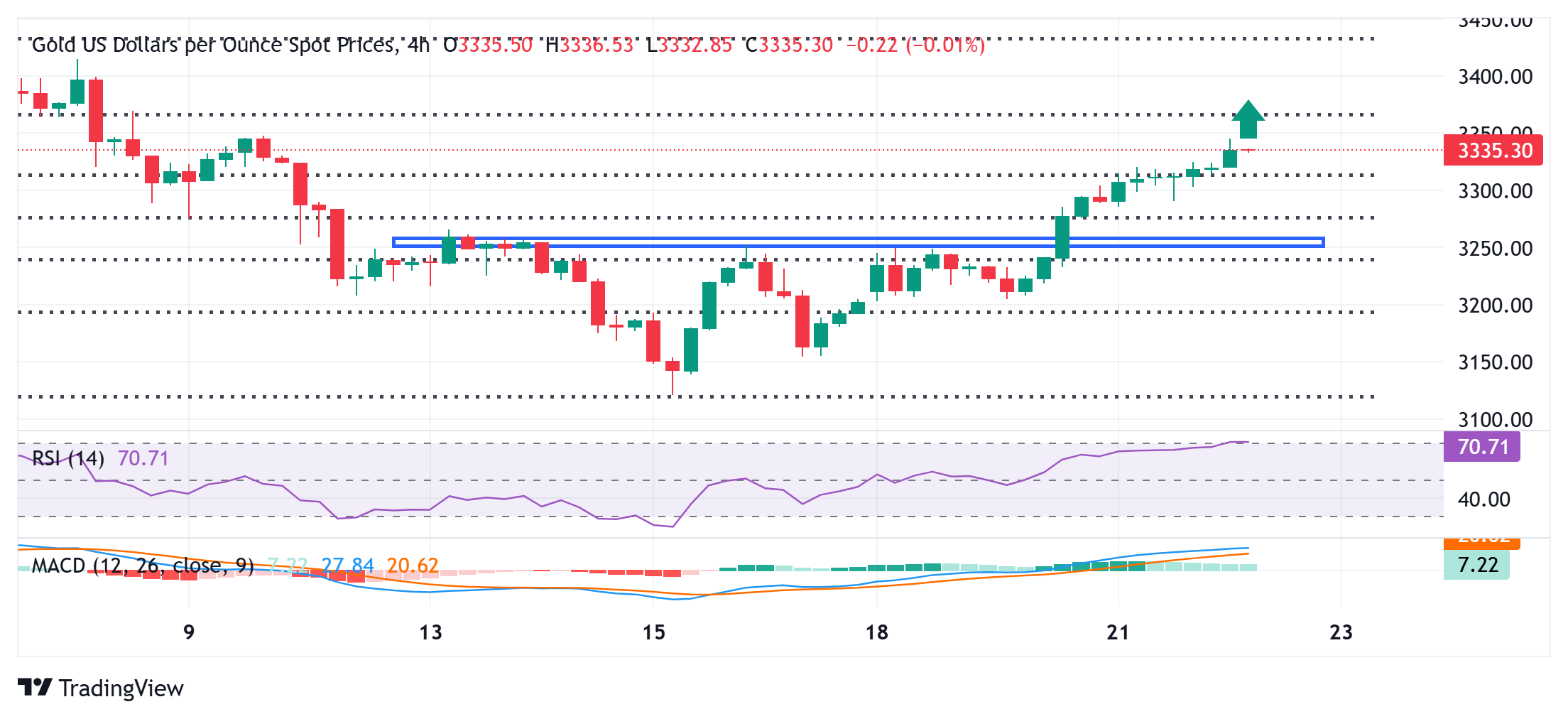- Gold price scales higher for the fourth straight day amid a combination of supporting factors.
- US fiscal concerns and Fed rate cut bets undermine the USD, benefiting the precious metal.
- Renewed US-China trade tensions and geopolitical risks further support the XAU/USD pair.
Gold price (XAU/USD) prolongs the uptrend for the fourth consecutive day and climbs to a nearly two-week high, around the $3,344-3,345 area during the Asian session on Thursday. Investors remain on edge following the US sovereign credit rating downgrade by Moody’s and growing worries about rising US deficit on the back of US President Donald Trump’s sweeping tax bill. Moreover, renewed US-China trade tensions, along with geopolitical risks, hit the global risk sentiment and continue to benefit the safe-haven precious metal.
Meanwhile, a poor response to the 20-year US bond auction reinforced the view that market participants are shying away from US assets. Apart from this, the growing market acceptance that the Federal Reserve (Fed) will lower borrowing costs further in 2025 amid easing inflationary pressures and a sluggish economic growth outlook contributes to the prevalent US Dollar (USD) selling bias. This turns out to be another factor driving flows towards the non-yielding Gold price and supports prospects for a further near-term appreciating move.
Daily Digest Market Movers: Gold price buying remains unabated amid safe-haven demand, weaker USD
- The Republican-controlled US House of Representatives Rules Committee voted to advance President Donald Trump’s sweeping tax-cut and spending bill, setting the stage for a vote on the House floor. The highly anticipated “One Big, Beautiful Bill” could add around $3 trillion to $5 trillion to the country’s already hefty debt pile.
- Furthermore, a crucial auction of 20-year Treasury bonds on Wednesday saw soft demand, pointing to growing worries that the tax and spending bill will worsen the US budget deficit at a faster pace than previously expected. This comes after Moody’s downgraded the US sovereign credit rating from the top “Aaa” last Friday.
- The US Dollar has been trending lower on the back of US fiscal concerns. Adding to this, bets that the Federal Reserve will lower interest rates further this year amid evidence of easing inflation and a dismal growth forecast continue to push the USD lower, lifting the non-yielding Gold price to a nearly two-week high on Thursday.
- Meanwhile, China accused the US of abusing export control measures and violating Geneva trade agreements after the US issued guidance warning companies not to use Huawei’s Ascend AI chips. China’s Commerce Ministry said on Wednesday that US measures on advanced chips are ‘typical of unilateral bullying and protectionism.’
- On the geopolitical front, Israel’s military continued to pound the Gaza Strip and block desperately needed food aid. Adding to this, Trump reportedly told European leaders that Russian President Vladimir Putin isn’t ready to end the war with Ukraine as he thinks he is winning, which lends additional support to the safe-haven commodity.
- Traders now look to the release of flash PMI prints for a fresh insight into the global economic health. The US economic docket also features the release of the usual Weekly Initial Jobless Claims and Existing Home Sales, which might influence the USD. This, along with the broader risk sentiment, could drive the precious metal.
Gold price seems poised to reclaim the $3,400 mark

From a technical perspective, the XAU/USD pair now seems to have found acceptance above the 61.8% Fibonacci retracement level of the recent downfall from the monthly peak. This comes on the back of this week’s breakout through the $3,250-3,255 resistance zone and favors bullish traders. Moreover, oscillators on the daily chart have been gaining positive traction and suggest that the path of least resistance for the Gold price remains to the upside. Hence, a subsequent move towards the next relevant hurdle near the $3,363-3,365 region, en route to the $3,400 round figure, looks like a distinct possibility.
On the flip side, the $3,316-3,315 area, or the 61.8% Fibo. retracement level resistance breakpoint now seems to protect the immediate downside ahead of the $3,300 mark. Any further decline below the $3,285 area is more likely to attract fresh buyers and remain limited near the $3,255-3,250 hurdle-turned-support. A convincing break below the latter, however, might prompt some technical selling and drag the Gold price to the $3,200 mark.
Gold FAQs
Gold has played a key role in human’s history as it has been widely used as a store of value and medium of exchange. Currently, apart from its shine and usage for jewelry, the precious metal is widely seen as a safe-haven asset, meaning that it is considered a good investment during turbulent times. Gold is also widely seen as a hedge against inflation and against depreciating currencies as it doesn’t rely on any specific issuer or government.
Central banks are the biggest Gold holders. In their aim to support their currencies in turbulent times, central banks tend to diversify their reserves and buy Gold to improve the perceived strength of the economy and the currency. High Gold reserves can be a source of trust for a country’s solvency. Central banks added 1,136 tonnes of Gold worth around $70 billion to their reserves in 2022, according to data from the World Gold Council. This is the highest yearly purchase since records began. Central banks from emerging economies such as China, India and Turkey are quickly increasing their Gold reserves.
Gold has an inverse correlation with the US Dollar and US Treasuries, which are both major reserve and safe-haven assets. When the Dollar depreciates, Gold tends to rise, enabling investors and central banks to diversify their assets in turbulent times. Gold is also inversely correlated with risk assets. A rally in the stock market tends to weaken Gold price, while sell-offs in riskier markets tend to favor the precious metal.
The price can move due to a wide range of factors. Geopolitical instability or fears of a deep recession can quickly make Gold price escalate due to its safe-haven status. As a yield-less asset, Gold tends to rise with lower interest rates, while higher cost of money usually weighs down on the yellow metal. Still, most moves depend on how the US Dollar (USD) behaves as the asset is priced in dollars (XAU/USD). A strong Dollar tends to keep the price of Gold controlled, whereas a weaker Dollar is likely to push Gold prices up.

